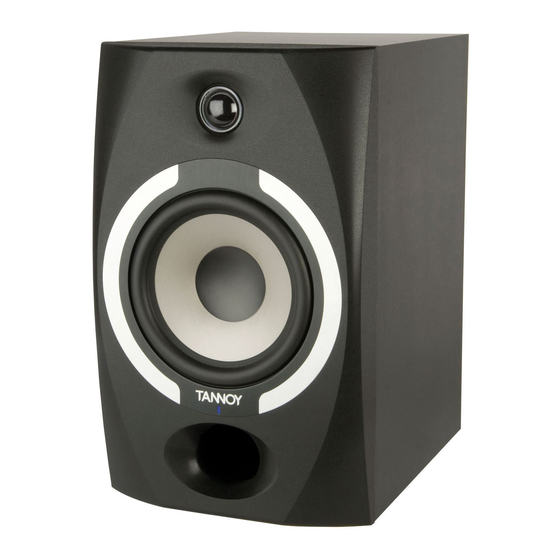Table of Contents
Advertisement
Advertisement
Table of Contents

Summary of Contents for Tannoy Reveal
- Page 1 Reveal Nearfield Monitors User Manual...
- Page 2 Telephone: +44 (0)1236 420199 Fax: +44 (0)1236 428230 Internet:http://www.tannoy.com Tannoy North America Inc. 335 Gage Avenue, Suite 1, Kitchener, Ontario, CANADA, N2M 5E1 Telephone: (519) 745 1158 Fax: (519) 745 2364 Tannoy Nederland BV, Anthonetta Kuijlstraat 19, 3066 GS, Rotterdam THE NETHERLANDS...
-
Page 3: Table Of Contents
CONTENTS INTRODUCTION THE BASICS Unpacking and visual checks Preliminary recommendation Connecting your speakers Observing polarity Power Amplifiers PLACEMENT OF THE SPEAKERS Orientation Positioning Console Reflections Speaker Mounting Bass Ports Equalization PERFORMANCE DATA TECHNICAL SPECIFICATIONS SERVICING Cabinet finish Driver removal Crossover List of spare parts WARRANTY Declaration of Conformity... -
Page 4: Introduction
We know you are serious listeners or you wouldn’t have bought Tannoy monitors. We decided that someone needed to produce this type of manual, and because we’re actually interested in monitoring, not just speaker sales, we figured it would have to be us. -
Page 5: Observing Polarity
Due of the high peak power handling of Tannoy monitors, responsible use of even more powerful amplifiers should not represent a danger to the speakers if the amplifiers are not overdriven. Now, just because you have a Ferrari, it doesn’t mean to say you can drive it at the red line all of the... -
Page 6: Placement Of The Speakers
3.0 PLACEMENT OF THE SPEAKERS Now here’s the truly critical stuff. Speaker placement and the listening environment can completely compromise the performance of any loudspeaker, no matter how much it costs. It is important to understand some limitations of near-field speakers, and the operating environment, in order for you to gain the maximum performance from the pair sitting in front of you. - Page 7 In the diagrams below we have a graphical representation of the speaker systems operating at the crossover point where both high and low frequency drivers produce the same output level. The first one shows a pair of two-way loudspeakers lying on their side. Note that each driver is producing sound, and because there is a physical distance separating them on the baffle, there is also a time difference separating the drivers, and the result is what you see here.
- Page 8 Another interesting note, the Tannoy true point-source Dual Concentric© monitors are free from the physical offsets previously described, which means that the behavior of the Dual Concentric monitors will not change in the horizontal, vertical or any other plane you can pick. The other neat thing about Dual Concentric monitors is that no matter how close you get to them you can’t get...
-
Page 9: Positioning
EQ, or leaning back and listening to the mix. Don’t go crazy trying to get this exact to three decimal places, within a few inches will suffice. Your Tannoy monitors have a wide sweet spot both horizontally and vertically to reduce the variations in sound quality as you move around doing your recording engineer stuff. -
Page 10: Console Reflections
3.3 Console Reflections The number one killer of smooth near-field monitor response is the mixing console. Most people park their near-field monitors on top of the meter bridge, which makes the console top the most influential reflecting surface for the sound you hear when you’re mixing. How important is that reflection? If it were such a big deal, wouldn’t people have done something different by now? Let’s face it, this industry is not exactly quick to acknowledge a situation that makes it apparent we’ve ignored a problem for the ten years or so since near-fields became popular. - Page 11 to the speaker’s response, because the ear/brain reads reflections arriving within 10 milliseconds of the direct sound as being part of the speaker’s response, these reflections can pull the stereo image around in different directions at different frequencies. Enough theory, now to the lab. Here’s where we have fun with science.
-
Page 12: Speaker Mounting
3.4 Speaker Mounting You’ve probably got your monitors delicately balanced on your console meter bridge, or sitting on a counter top beside your hard disc editor. Find some music with some real solid low end that you know well. Try listening to this music with the speaker sitting directly on the mounting surface and then with it sitting on a thin piece of rubber pad. -
Page 13: Performance Data
4.0 PERFORMANCE DATA Fig 1. On axis anechoic frequency response Fig 2. Impedance... -
Page 14: Technical Specifications
Tannoy operates a policy of continuous research and development. The introduction of new materials or manufacturing methods will always equal or exceed the published specifications which Tannoy reserve the right to alter without prior notice. Please verify the latest specifications when dealing with critical applications. -
Page 15: Servicing
Coatbridge, Strathclyde ML5 4TF Telephone 01236 420199 (UK) +44 1236 420199 (International) 01236 428230 (UK) +44 1236 428230 (International) Internet: http://www.tannoy.com DO NOT SHIP ANY PRODUCT TO TANNOY WITHOUT PREVIOUS AUTHORISATION. This warranty in no way affects your statutory rights. -
Page 16: Declaration Of Conformity
Declaration of Conformity The following apparatus is/are manufactured in the United Kingdom by Tannoy Ltd of Rosehall Industrial estate, Coatbridge, Scotland, ML5 4TF and conform(s) to the protection requirements of the European Electromagnetic Compatibility Standards and Directives relevant to Domestic Electrical Equipment.

















Need help?
Do you have a question about the Reveal and is the answer not in the manual?
Questions and answers